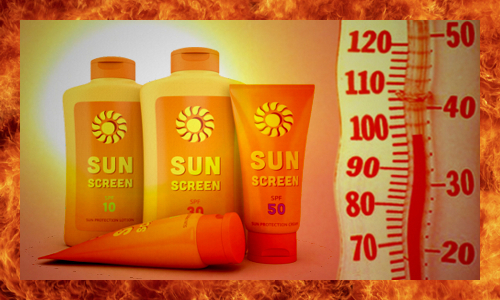Sunscreen safety rules for runners

It's summertime! Warmer weather, longer days, and time spent outside soaking up the sun. If you are a runner, you already know the feeling of leaving for a long run in the cool early morning hours and returning with the warm sun on your shoulders as the day heats up. Being outside in the elements is one of the reasons why I love the sport of running. But, there are dangers to spending too much time in the sun. According to the American Cancer Society, one person dies from melanoma cancer every hour! Each year there are more new cases of skin cancer than cancers of the breast, prostate, lung and colon combined. Protecting our skin is essential to our longevity and our overall health.
Wear sunscreen and apply it more than once a day - There are a lot of things being said about the dangers of sunscreen. We hear that it is poisoning our children, changing our hormonal balance, causing cancer, and lots of other scary things. But, no one will tell you that you are better off burning your skin and blistering in the sun. Protect yourself with sunscreen. Putting it on before you go out is a no-brainer, but you also need to reapply sunscreen every few hours throughout the day. For runners and athletes, this is especially true if you are sweating or getting in and out of the water.
Lotions are better than sprays - Sorry, kids. The lotions take longer to soak in and feel slimier, but they are more effective according to Dr. Abrar Qureshi, chair of dermatology at Brown University's Warren Alpert Medical School. "With sprays, people often don't apply enough to get the full sunscreen protection," Qureshi said. However, if you find yourself alone, you may find it easier to cover those hard to reach places like the middle of your back with a spray. Then again, that's a great excuse to meet someone new... Sprays tend to blow around and disperse in the wind. That leaves uneven sunscreen coverage at best, no coverage and a mouthful of chemicals and carcinogens at worst. Hold your nose, close your mouth, and shut your eyes to avoid breathing in the nasty stuff.
Read the labels - Not all sunscreens are safe according to The Environmental Working Group (EWG). In a recent study of over 2000 sunscreens and over 257 brands, they found more than 75% of the sunscreens contained toxic chemicals. According to the report, "some have toxic effects. Some release skin-damaging free radicals in sunlight, some act like estrogen and disrupt hormones, and several can cause allergic reactions and skin irritation." Here are the offending chemicals to avoid when possible: Para amino benzoic acid, Octyl salicyclate, Oxybenzone, Cinoxate, Dioxybenzone, Phenylbenzimidazole, Homosalate, Menthyl anthranilate, Octocrylene, Methoxycinnamate, and Parabens.
Minerals are better than chemicals - Zinc and titanium are minerals. They do not breakdown in sunlight, are not usually absorbed, are non-allergenic and are more effective at blocking UVA rays than non-minerals. Sunscreens made with these ingredients are usually recommended for babies and lifeguards. Did you ever notice the white, yellow, pink or green stripes on their noses? As to the harmful effects of the chemicals used in sunscreen, not everyone is in agreement about how harmful they might actually be. But, we know that the FDA is falling behind on their reviews of new and potentially safer sunscreen ingredients. Nothing new has been approved for the last fifteen years. Urvashi Rangan, director of consumer safety and sustainability at the Consumers Union, publisher of Consumer Reports, says "If there are safer alternatives to chemicals than those now used, it would benefit consumers to have them."
The best solution is limiting exposure - Don't bake, bask, or bronze. Any damage to your skin will haunt you forever. The Harvard Nurses Health study found that those who had at least five blistering sunburns when they were 15 to 20 years old had a 68% increased risk for common skin cancers. And, an 80% increased risk of the deadlier melanoma by the time they reached middle age. A hat and a shirt are still the best protection from the sun's harmful rays. Dress appropriately. If you are leaving the house for a long summer run, put on some sunscreen, grab a water bottle, and wear a tech T-shirt and a hat. The hours of 10 a.m. to 4 p.m. are best to avoid if possible.
Twenty minutes of sun is good for you - We all need the vitamin D3 that sunshine provides. D3 has been found to improve our immune systems, our mood, and our ability to fight cancer. Contrary to what you may read, there is no evidence that sunscreen prevents absorption of this essential vitamin. Twenty minutes in the sunshine is all you need to get the full daily benefit.
Athletes are at greater risk of developing skin cancer - It seems counter intuitive that the healthy, tanned athletes we see playing sports are at a greater risk for skin cancer, but that's the truth according to dermatologist Brian B. Adams, MD, MPH, FAAD, and chairperson of the American Academy of Dermatology (AAD) Sports Committee. "Outdoor athletes face double jeopardy because perspiring exacerbates their risk." The sweat on our skin actually lowers the minimal amount of sunlight it takes to make our skin turn pink and begin to burn. "It is important for athletes to follow sun-safety precautions, including wearing sunscreen and protective clothes when they workout or play in the sun" says Alex Mroszczyk-McDonald, MD.
Apply sunscreen before going out - You should apply sunscreen to your dry skin at least fifteen to thirty minutes before going outside. Use the lotion on all exposed areas and pay particular attention to the face, ears, hands and arms. Most people do not put enough of the product on their skin and are not properly protected. Be sure to coat the skin liberally. Water, snow and sand act as multipliers due to the reflected sun rays. Always be extra careful in the those elements. And cloudy days are no exception. Up to 80% of the sun's ultraviolet rays can pass through the clouds.
Protect yourself from the inside out with healthy foods - Spinach, berries, tomatoes, and other foods rich in antioxidants can help the body repair skin damage caused by the sun. Also, eating diet with vitamin E (almonds sunflower seeds, avocados), Omega 3 fatty acids (walnuts, sardines, salmon), and beta-carotene (sweet potatoes, carrots) will help keep your skin healthy. And, of course, drink plenty of clean water.
Treating sunburns - Act quickly. When you feel the stingy sensation of a burn, or you see the pink skin it's already too late. According to skincancer.org these are the steps you should follow:
1. Moisturize - After a cool shower or bath, slather on a moisturizing cream or lotion to soothe the skin. Repeat often to make peeling and flaking less noticeable.
2. Hydrate - Any burn draws fluid to the skin surface and away from the rest of the body. So drink extra water, juice and sports drinks for a couple of days and watch for signs of dehydration: dry mouth, thirst, reduced urination, headache, dizziness and sleepiness.
3. Medicate - Take a dose of ibuprofen (Advil) as soon as you see signs of sunburn and keep it up for the next 48 hours.
4. Assess - If a blistering burn covers 20% or more of the body (the entire back), seek medical attention. Anyone with a sunburn who is suffering fevers and chills should also seek medical help.
Credits - WorldwideRunning.com would like to thank Saltmarsh Running for the permission to reprint the article "10 Sunscreen Safety Rules for Runners" by Jason Saltmarsh. Jason is an RRCA certified Adult Distance Running Coach and competitive masters runner from seacoast New Hampshire. The goal of Saltmarsh Running is to share with others the benefits and joys of running, fitness and healthy living. It features training resources, shoe and gear reviews, healthy recipes, and stories about the running life.
 | Running with sun protection - Cumulative exposure to the sun is a continuing challenge. A minimal running-apparel approach to running gear may feel more comfortable but the increased exposure to the sunlight increases the possibility of developing cancer. When running, the best approach is to use sunscreens and sun protectors. |

